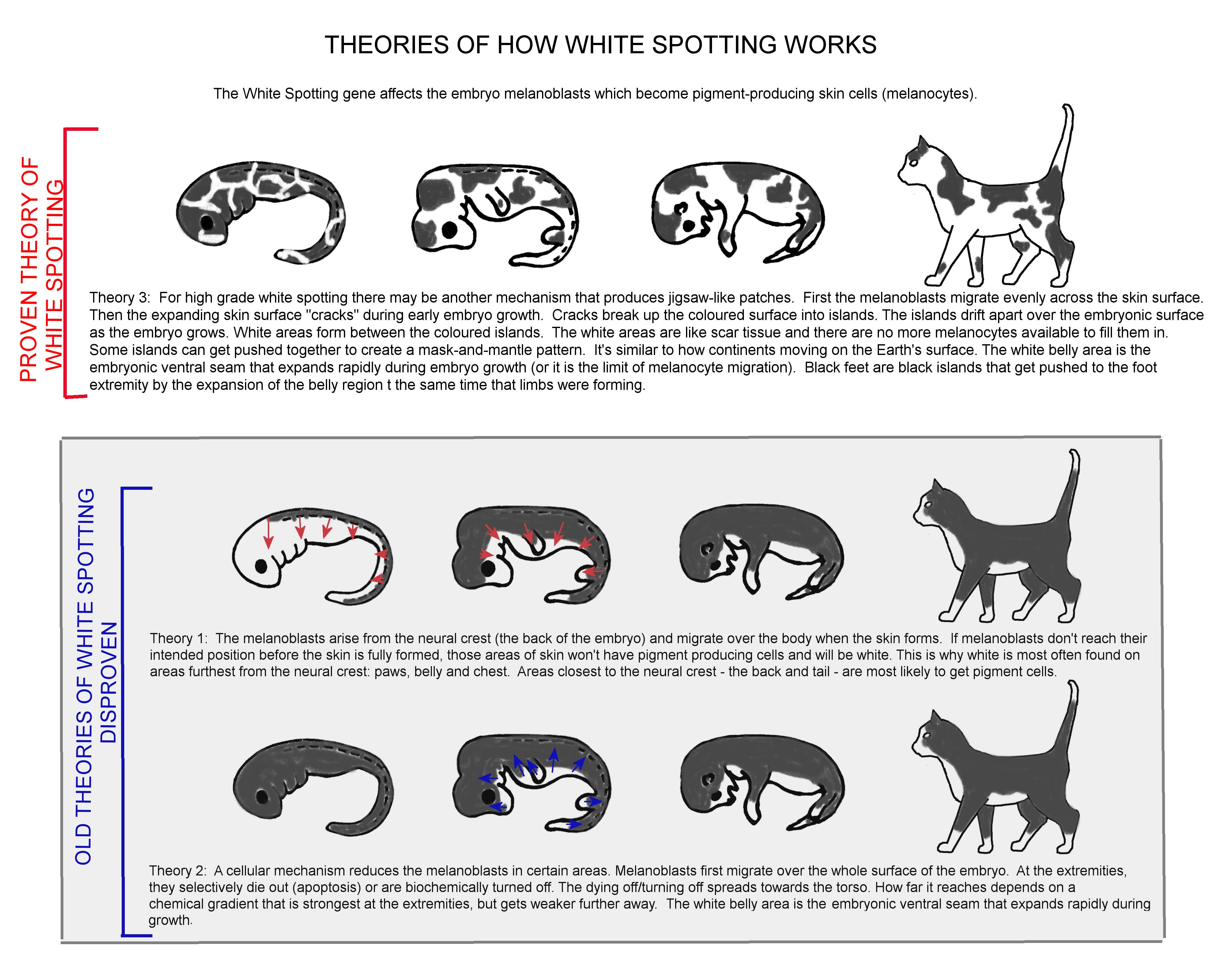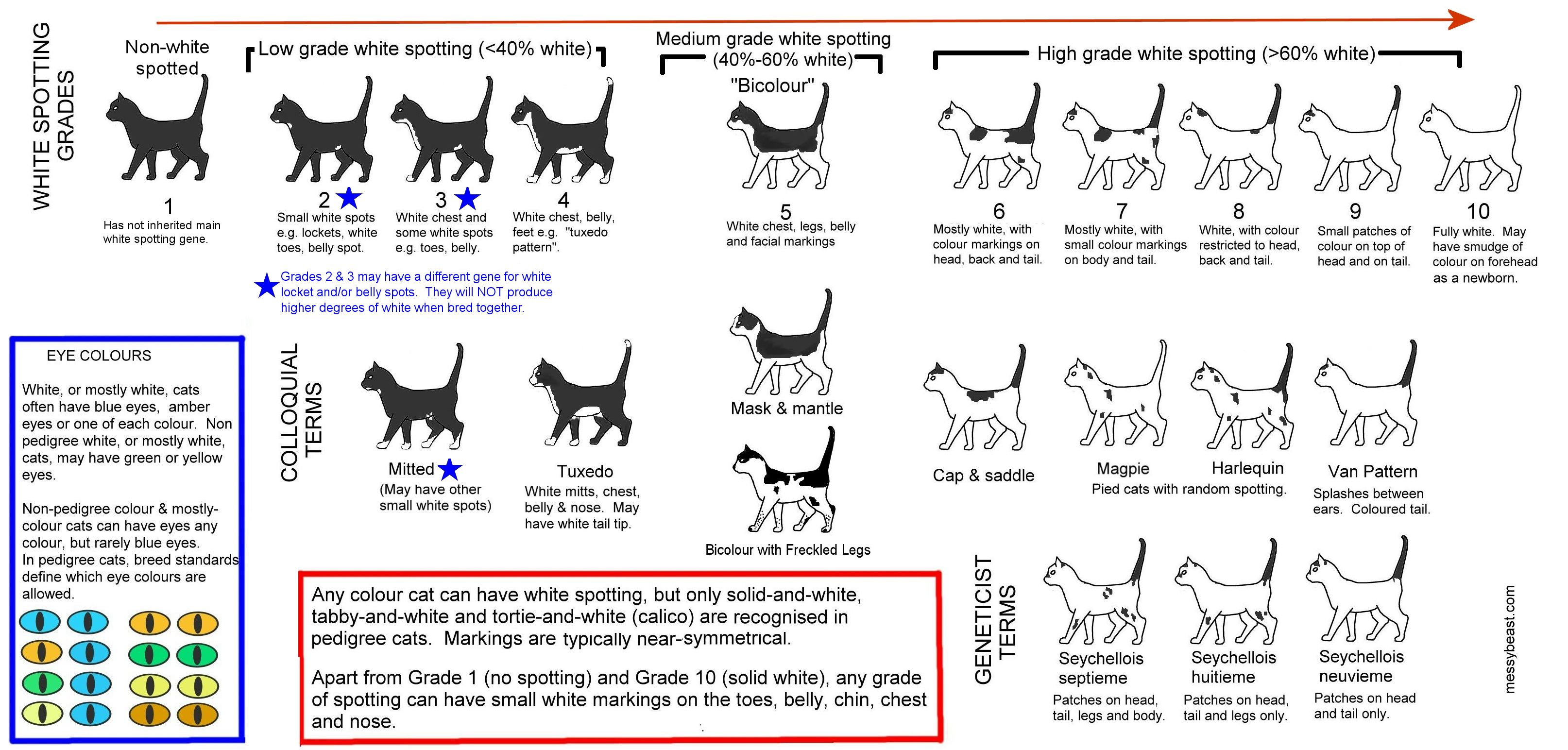
Bicolour cats go by various names and come in many patterns. They range from almost solid colour cats with a white throat locket or white tail-tip, through to almost solid white cats with black smudges on the nose or between the ears. You may have heard of them as tuxedo cats (white mitts, white belly and white chin with an optional white tail-tip) or patched, pied, particoloured, harlequin or magpie cats (usually white with coloured splashes on the back and top of the head). The term covering all bicolour cats is "piebald" or "white spotted" with some variants of the pattern being called the Seychelles pattern.
DIFFERENT TYPES OF PIEBALD


The diagram above shows a typical progression from solid colour through to solid white. The number by each diagram is the "Grade" of spotting from Grade 0 (no spotting) through to Grade 10 (white spotting has obscured all of the base colour). The "solid colour" can be one of the true solid colours e.g. black or grey, or a tabby colour or tortoiseshell (the bicolour is then known as a calico and is actually a tricolour). Non-pedigree cats have a diverse range of combinations not recognised in the pedigree world - the "solid" area can be Abyssinian ticked (Aby-and-white), smoke, shaded or tipped. Black-smoke-and white is an attractive combination if not actually encouraged!
The Van pattern seen in pedigree Turkish Van cats and in the Seychellois (a Van-patterned Oriental) is Grade 8 - Grade 9 Piebald and represents the most extreme of the 'Seychelles' patterns. In the Turkish Van, the colour is restricted to auburn (red) or cream patches on the head at the base of each ear; the tail is the same colour as patches, often with darker rings because red and cream are not true solid colours. Although auburn has long been the traditional colour of Turkish Van markings, other colours are being developed within different cat fancies, but in its native Turkey, the Turkish Van actually refers to an all-white cat (Van Kedi).
|
|
|
|
|
The Van pattern is also found in Persian Longhairs in the form of Van Bi-Colours & Harlequins. These often have additional markings on legs, and one or two small splashes of colour on the body. The Seychellois is an Oriental type cat, occurring in both longhair and shorthair forms, exhibiting varying degrees of the Van pattern:-
Seychellois Neuvieme is a white cat with coloured tail and head splashes
Seychellois Huitieme is white with coloured tail and head splashes plus additional splashes of colour on the legs
Seychellois Septieme has splashes of colour on the legs and body in addition to those on the head and the coloured tail.
British cat fancier Pat Turner defined the different levels of white spotting as: Grade 2 - "White Trim"; Grade 3 - "Mitted"; Grade 4 - "Irish"; Grade 5 - "Saddle"; Grade 6 - "Pied"; Grade 7 - "Chinese"; Grade 8 - "Harlequin"; Grade 9 - "Van". In exhibition-quality bicolour cats, symmetrical markings were preferred.
The placement of the colour patches is variable and related to how the embryo develops and expresses the genes it has inherited. As a result, even more extreme colour restrictions can turn up, for example Wanda below (photos provided by Peggy Alden-Clapper) is an eyecatching variation on Grade 9 Piebald - all white apart from a black tail, but no splashes of colour on the head or body.
|
|
|
In 1896, Jean Bungartz wrote in his "Illustrated Book of Cats" (in German only): The black-headed or Mohrenkopf (Moorish-headed) cat must be clean white, with contrasting colour on the head and tail. Consistent specimens of this variety are extremely rare and it can probably be regarded as one of the most peculiar colour patterns of the domestic cat. The colour of the head and tail can be either black, grey, blue or yellow with no white hairs except those regularly showing up on the head. As previously mentioned, cats with good and correct markings are highly valued.
THE TYPICAL RANGE OF BICOLOUR PATTERNS
Piebald cats are extremely common and varied in appearance. The white spotting can occur with any colour/pattern and varies from minimal white through to almost all white. The smallest amount of white may be no more than a white locket and a small white belly patch, each no more than a few white hairs. Though this pattern doesn't have a descriptive namem the term "locket cat" has been suggested. The image at the top of this page and the description below is a typical progression through the different grades of piebald. Due to developmental effects at the embryo stage, there are further variations on this general theme!
|
|
|
|
|
At one end of the scale is the white locket, followed by the familiar tuxedo pattern where the belly is largely white. As the degree of white spotting increases, the white spreads up the neck and onto the chin (as shown in the three-quarter Persian above). The cheeks may be white or have white spots and there may be a white blaze (an inverted V) from the muzzle up between the eyes or a white "teardrop" on the nose (as shown in the cat above right). If the neck and chin are white, the front paws are also usually white.
|
|
|
|
|
As the degree of white spotting increases further, the white extends up the sides of the cat, up the forelegs (stockings) and onto the hind paws. The next step is all white hind legs, white fully around the neck and the white blaze may extend right between the ears. Some cats also have white ear tips. This pattern is sometimes known as "mantled" because the cat appears to be wearing a coloured cape with a hood or mask. The mask-and-mantle is a common bicolour pattern as shown above. As the amount of white increases further, it simply shrinks the mantle into a saddle. The mask may also shrink back to a "cap" giving the cap-and-saddle pattern (as with the cat in the above centre photo). Further white spotting breaks the saddle up into smaller patches as shown in the black-and-white Grade 7 piebald cat. Sometimes one or more white rings encircle the tail - for some reason this ringed effect seems more common in tabbies. With any degree of spotting, there may be coloured smudges on the cheeks, chin or nose. Some cats also have black toes on otherwise white paws.
Jean Bungartz described two bicolour patterns in his 1896 book "Die Hauskatze, ihre Rassen und Variet ten" (Housecats, Their Races and Varieties) in " Illustriertes Katzenbuch" (An Illustrated Book of Cats). His description of the "masked cat" is the tuxedo pattern, which he describes as "sometimes the tail-tip is white also. The eyes of this variety are bright yellow with black rims. Regular and sharply defined white patches create the most beautiful Mask Cats which have many admirers." Bungartz also describes a less familiar bicolour he calls the black-headed or Moor-headed cat (Mohrenkopf) which was clean white, except for the head and tail, which were black, grey, blue or yellow with no white interspersed "except those showing up regularly on the head". Consistent specimens of this variety were extremely rare and valuable. His illustration depicts a cat with wholly black head, but it is possible he was describing the Van pattern.
It is possible to combine piebald with colourpoint. Bicolour Siamese have been bred in Europe to a mixed reception. A few Himalayan breeders breed bicolour Himalayans, using bicolour Persians to introduce the white spotting pattern. Paul Beall, Richmond, Texas is one such breeder. Paula's photo (below) shows a bicolour (piebald) Himalayan, but unfortunately this cat has not produced piebald-point kittens and Paula has decided not to reintroduce the gene from Persians.
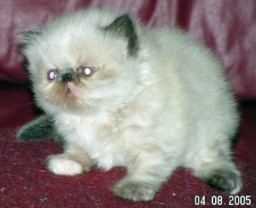
A pattern which has only rarely been reported in cats is the belt, blanket or sheet marking. This is common in pigs and cattle and in Dutch rabbits where a band of white encircles the animal's body like a belt. This pattern has occasionally been seen in Spanish feral cats. "Sheeted" means a wider the band of white i.e. from shoulders to haunches.
:
OTHER PIEBALD PATTERNS
not all cats fit neatly into the "typical patterns." There are quite possibly several genes which influence white spotting. For example, the patterns above might not be due to a single gene - there may be several other genes which modify its effects. There are also other piebald patterns which appear to be due to different genes or to cats being homozygous for a modifier gene since the effect is relatively uniform and predictable. The cat below, with a black rear end and white fore end and white tail-tip is from the Russian Topaz breed that has blue eyes, regardless of coat colour, as a breed characteristic. One parent is black with odd eyes, the other is black with a white facial blaze and blue eyes. It isn't known if the Topaz gene played a role in the the unusual distribution of white.

The gloves (mitts) on Birman and Snowshoe cats appear to be due to an incompletely dominant gene. The gloves may vary in length but they are restricted to feet and/or legs. The white markings on the forehead and chest of breeds such as the Snowshoe may also be due to a gene which limits the amount of white. Lockets - those small spots on the throat, chest, stomach and groin of otherwise solid coloured cats also seem to be due to a different gene - one which is normally hidden by the more extensive white spotting of piebald cats. There is also the phenomenon of white toes occurring on otherwise coloured cats.
In the York Chocolate breed, there is a particular white displacement in bicoloured individuals. The placement of white maintains the same configuration in all successive generations. This has been termed "Spotting Particolour" and may be due to an allele (variant) of the White Spotting gene. According to this theory, the White Spotting gene appears to have 4 variants: non-spotted, spotted, particolor, and Birman mitted. Spotted is the dominant form and is variable expressed. Non-spotted is the recessive wild-type and produces a coat without white. The hypothetical Birman allele (or Birman mitted) is also variable, but confines the white spotting to the legs and feet. The hypothetical Particolour allele produces an inverted white "V" with the apex in the centre of the forehead and passing through the centres of the eyes plus a white chin, chest, belly, legs and feet are white. Particolour is also variable and its least expression may be a white locket or white spot on the forehead. The existence of breeds such as the York Chocolate (consistent particolour pattern) and Birman and Snowshoe (consistent mitted pattern) appear to support the existence of a white particolour gene and a white mitted gene.
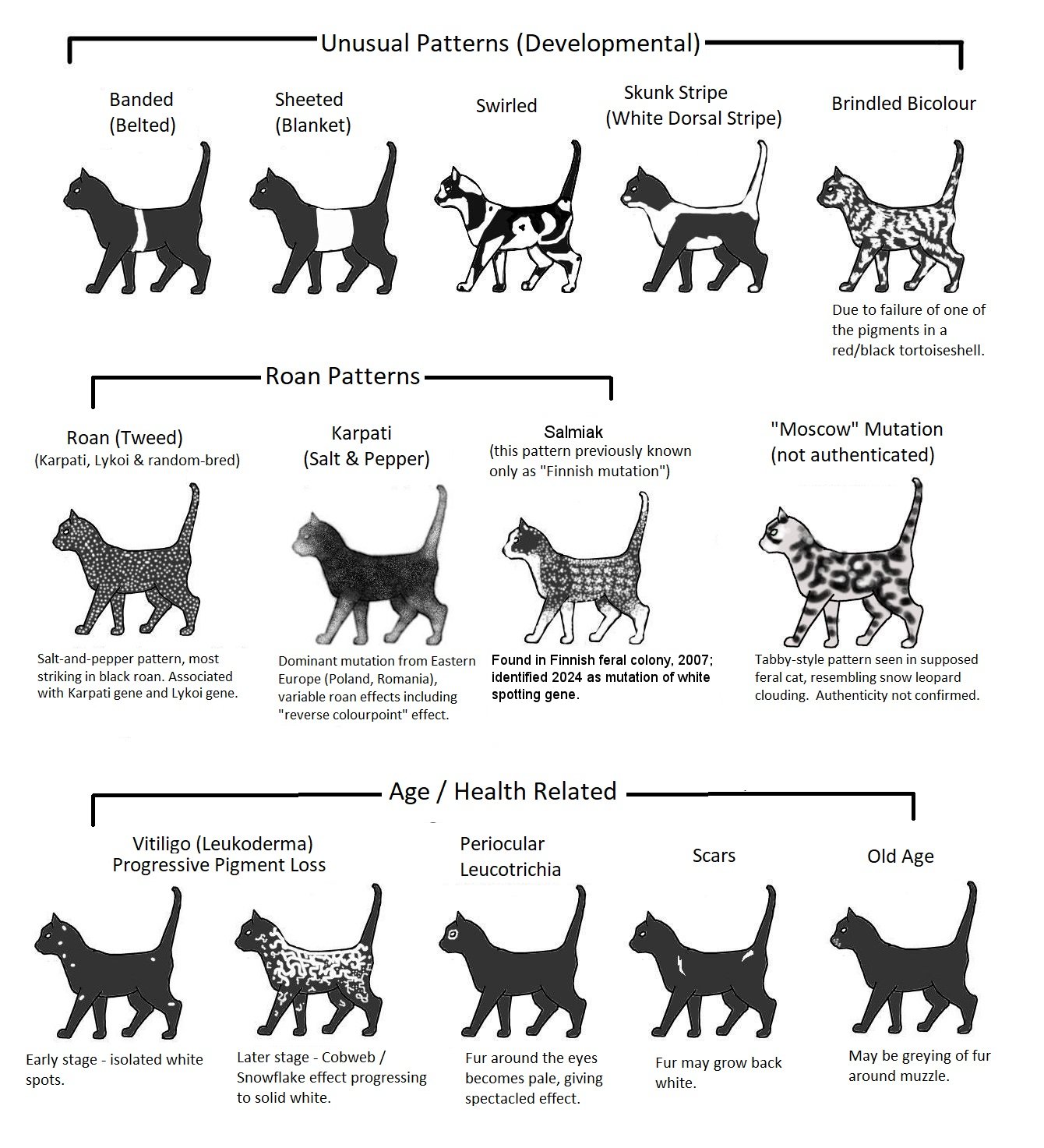
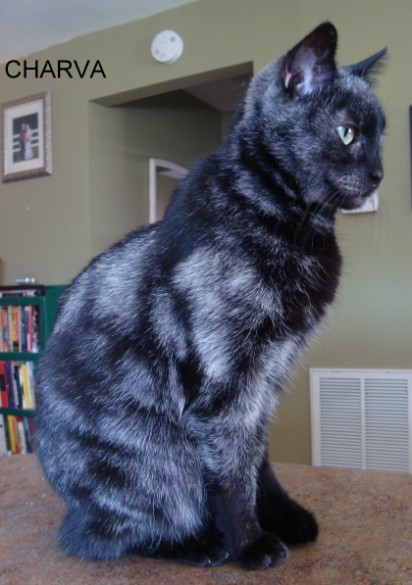
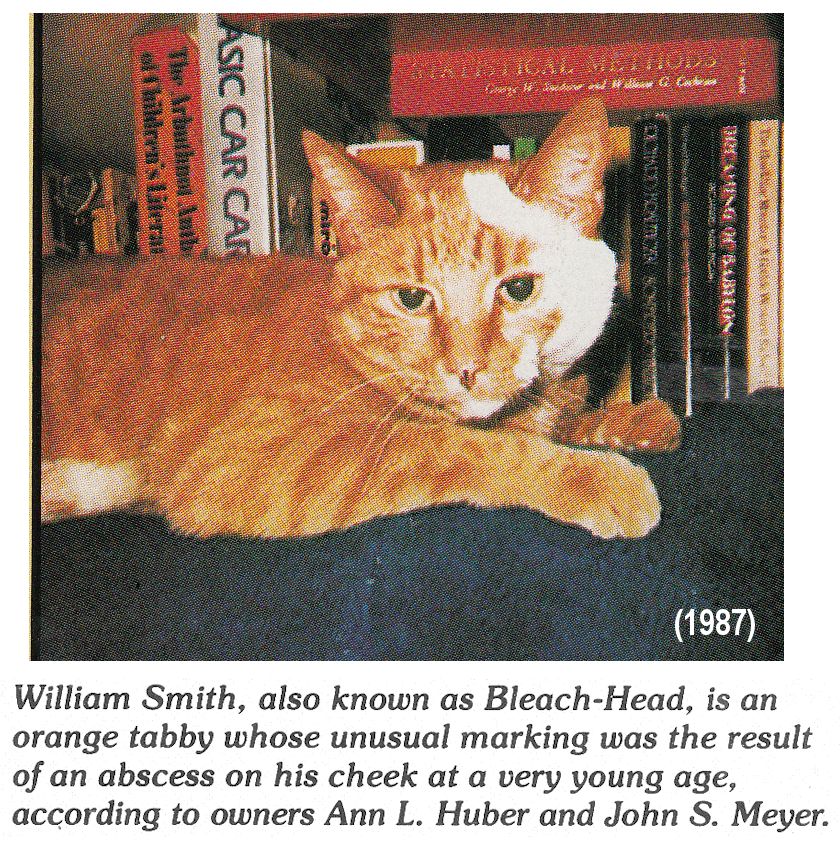 Leukoderma ("white skin"), leukotrichia ("white hair") or vitiligo, is a cosmetic condition that produces a progressive "snowflake" effect. The white spots become more extensive with age and the cat may become almost completely white. This must not be confused with the normal sprinkling of isolated white hairs which appear in a cat's fur during its lifetime. It is an "aquired depigmentation" and may be triggered by illness or environmental factors. "Charva" (Jason Reeves) has vitiligo; she was a black cat with patches of slightly longer/softer black hair. In 2009 she turned 4 and developed a patch of white hair. Since then the patches of white have turned into stripes, spots, and patches. Her skin is turning pink as well due to the loss of pigmentation. For more information see Bicolours - Depigmentation Conditions: Vitiligo, Leukoderma, Leukotrichia.
Leukoderma ("white skin"), leukotrichia ("white hair") or vitiligo, is a cosmetic condition that produces a progressive "snowflake" effect. The white spots become more extensive with age and the cat may become almost completely white. This must not be confused with the normal sprinkling of isolated white hairs which appear in a cat's fur during its lifetime. It is an "aquired depigmentation" and may be triggered by illness or environmental factors. "Charva" (Jason Reeves) has vitiligo; she was a black cat with patches of slightly longer/softer black hair. In 2009 she turned 4 and developed a patch of white hair. Since then the patches of white have turned into stripes, spots, and patches. Her skin is turning pink as well due to the loss of pigmentation. For more information see Bicolours - Depigmentation Conditions: Vitiligo, Leukoderma, Leukotrichia.
In 2011, Kimberly Sexton of New York City sent these photos of her cat Frankie. Kimberly's 14 year old cat Miko (white with grey markings on his head and tail) had recently died and in his last 3 years had formed a close bond with her younger cat, Frankie, a mackerel tabby. The two cats often slept intertwined. Two years before Miko passed away, Frankie developed a white spot of fur under his neck, while his chin and nose became paler. As time passed, Frankie's white areas spread and new ones developed around his neck and behind his shoulder blades. Kimberly joked to friends that Miko's white colour was rubbing off on Frankie as they slept! Frankie's white areas are likely to continue spreading, but the effect appears entirely cosmetic.
On coloured cats, hair regrowth around scars is often white. Lizzie Ellis (The Feline Rescue Association Inc, Maryland, USA) provided these photos of a grey male cat with white patches due to scarring. Where the skin was injured or burned, the fur has grown back white, not grey. The cat had suffered frostbite injuries. Some dark coloured cats show white hairs in their coat as they grow older - some follicles stop producing pigment, just as humans get "grey" hairs. Unlike the cobweb effect (where pigment loss occurs in patches, like snowflakes or strands of gossamer), age-related white hairs are evenly sprinkled across the body giving a salt-and-pepper effect; there may also be greying around the muzzle. It is a normal part of ageing although cats seem far less prone to getting grey hairs than do dogs. It should not be confused with the white patches found in vitiligo.
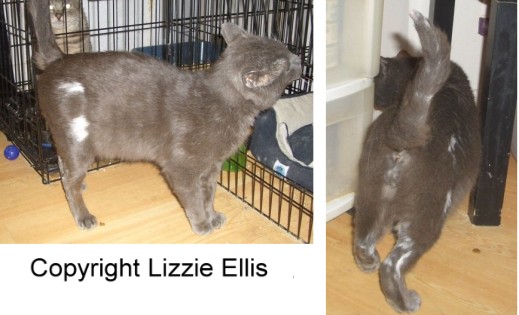
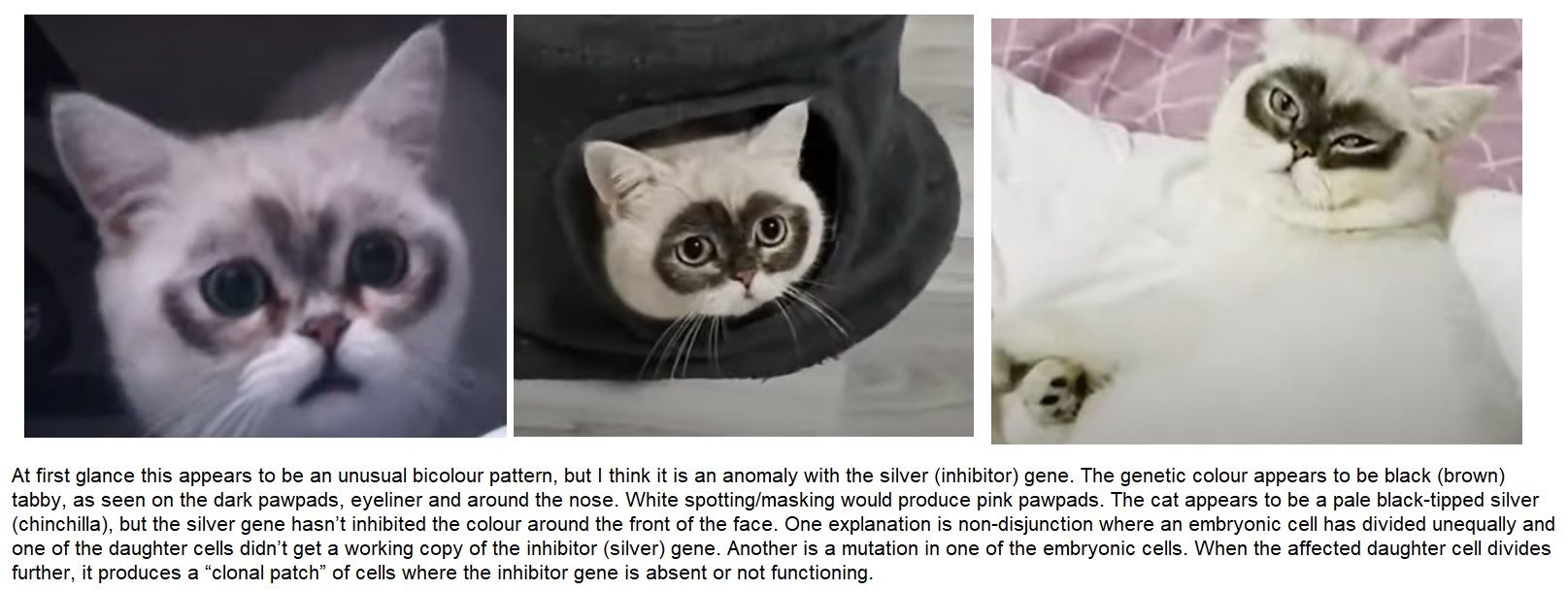
SWIRLED PATTERNS
While the piebald pattern is generally fairly symmetrical until the white exceeds 60% of the body surface, some cats exhibit a variety of swirled patterns. This may simply be due to the way the embryo developed or it may be the interaction between different genes which affect white spotting. The two cats below are unrelated, but both have swirled black and markings and black markings on the face. Both also have black toes. Coloured toes sometimes occur on bicolours - these can be individual toes or multiple toes. It may even look as though a white-footed cat has paddled through coloured paint, in which case the colour usually extends up the back of the leg. Coloured toes may possibly be another gene (modifier) interacting with the white spotting gene.Note: The cat shown top left has a mild form of radial hypoplasia which has caused her deformed forelegs; she also has a slightly deformed skull.
|
|
|
|
These photos of an unusual tabby and white called Chiyo were shared online by Nic Hall (and via Nayra Bernacki with permission). She had this pattern from birth so it's not vitiligo. Embryo development plays a part in the distribution of white in white-marked cats. White spotting in cats usually manifests as coloured patches on the back and white on the chest, belly and limbs through to almost solid white with residual patches of colour on the head, back and tail. Chiyo has mostly reversed this with tabby limbs and a random pattern of uneven patches on the body. The white around the eyes and on the forehead is also unusual; a white blaze or dark mask is more common, and Chiyo has the reverse of this. The coloured patches also seem to follow lines along and around the torso. Chiyo and one of her siblings have unusual white distribution. The brother has predominantly white forequarters, a coloured back legs. white spotting mutations occur from time to time. Chimerism hasn't been ruled out, and this can produce unusual patterns in animals. Chiyo has been spayed so there is no way of telling whether the pattern could be passed on.
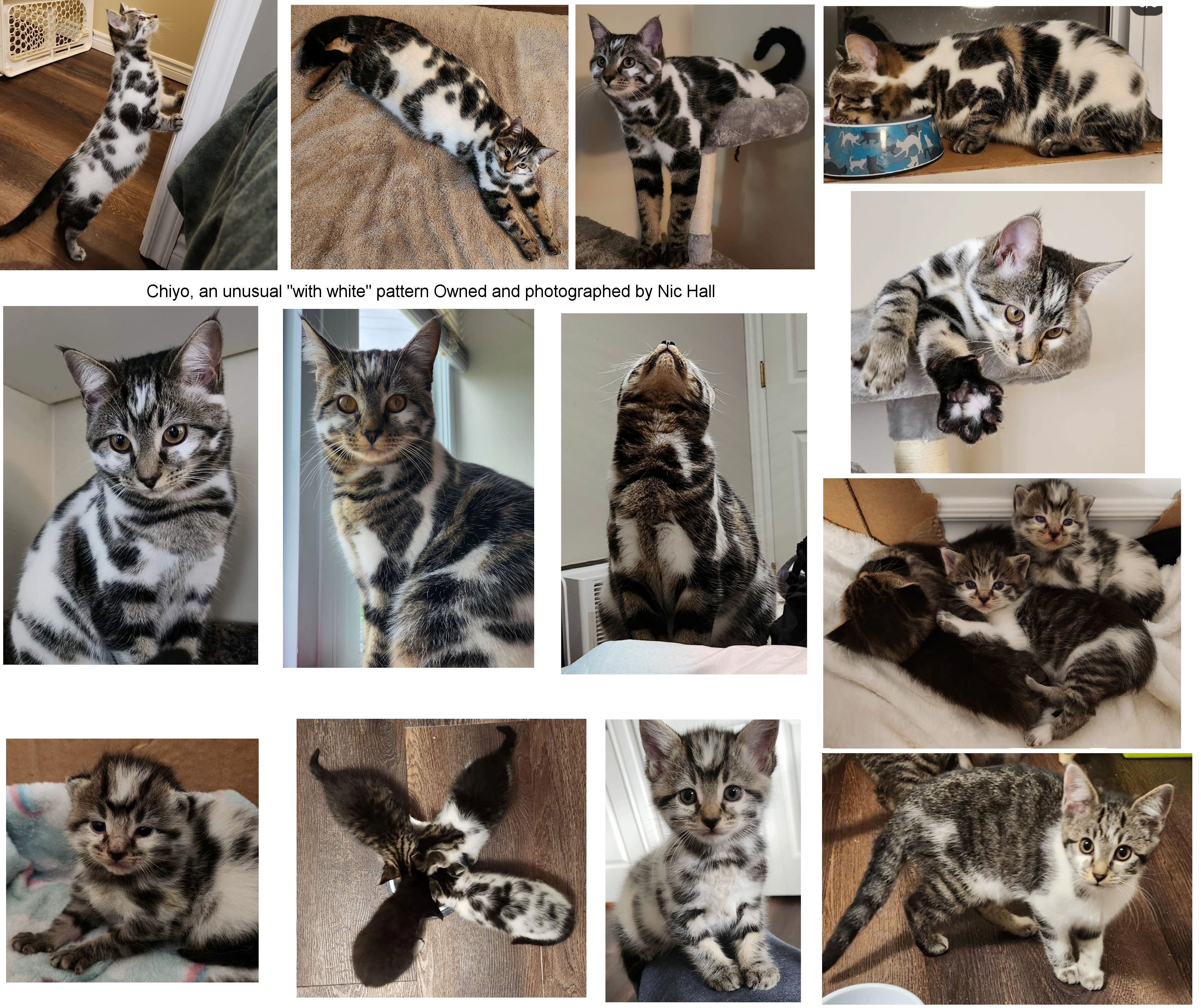
SKUNK STRIPES
More unusual is the "skunk marking" - a white dorsal stripe. Because early theories said that pigment producing cells migrated away from the neural crest, the dorsal area itself should remain coloured in low to medium grade spotting. In the case of a skunk stripe, the crack between areas of black is a straight line along the back rather than several random cracks (it's a cat with "continents" rather than "islands"! The appearance of a white dorsal stripe is unusual and appears to be hereditary especially as it was a recognised variety of cat in old Thai manuscripts. The Tamra Maew described a number of bicolour cat patterns, one of which was the But-Se-Weis/But-Tal-Lon, a black cat with a white dorsal stripe. The descriptions were considered fanciful by many western cat fanciers, but a growing interest in Thai breeds and the ease of uploading photographs to the internet has shown that the patterns do indeed exist. It is not a recognised pattern in any Western cat breed.
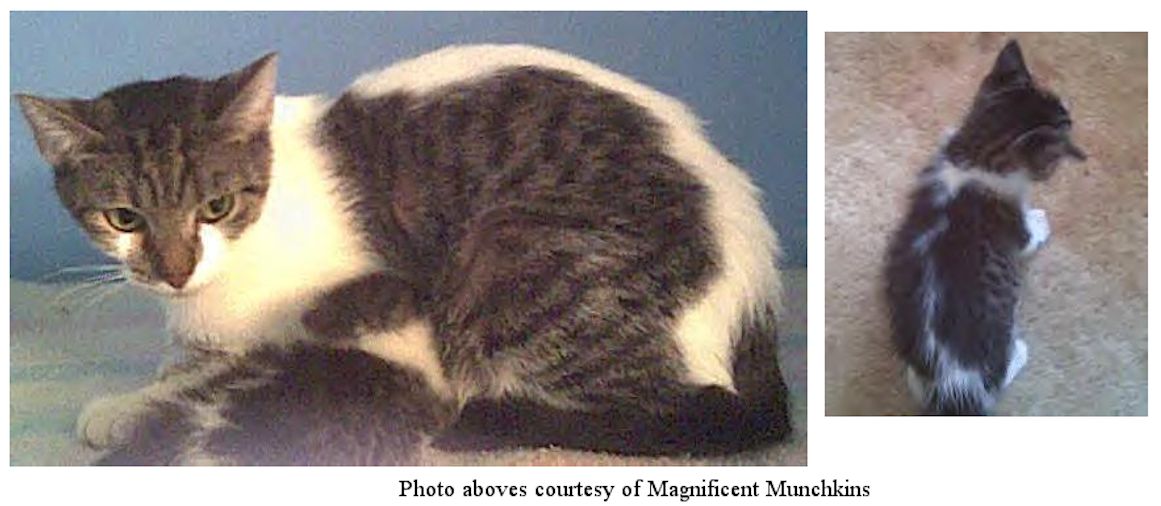
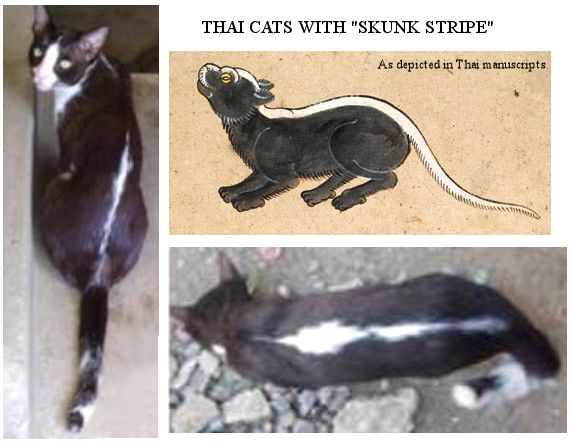
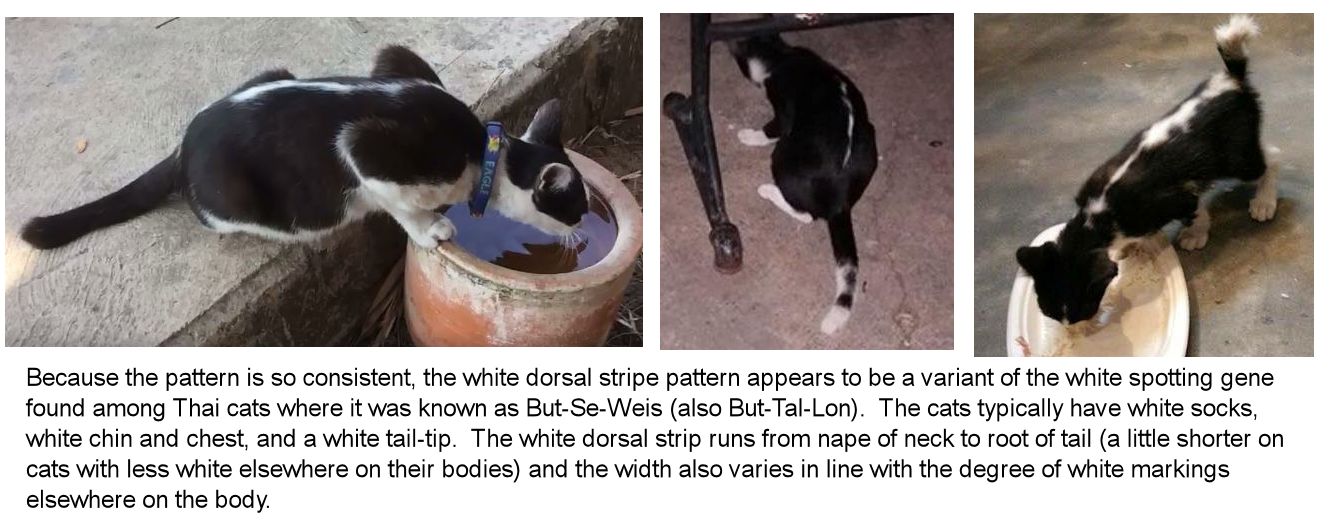
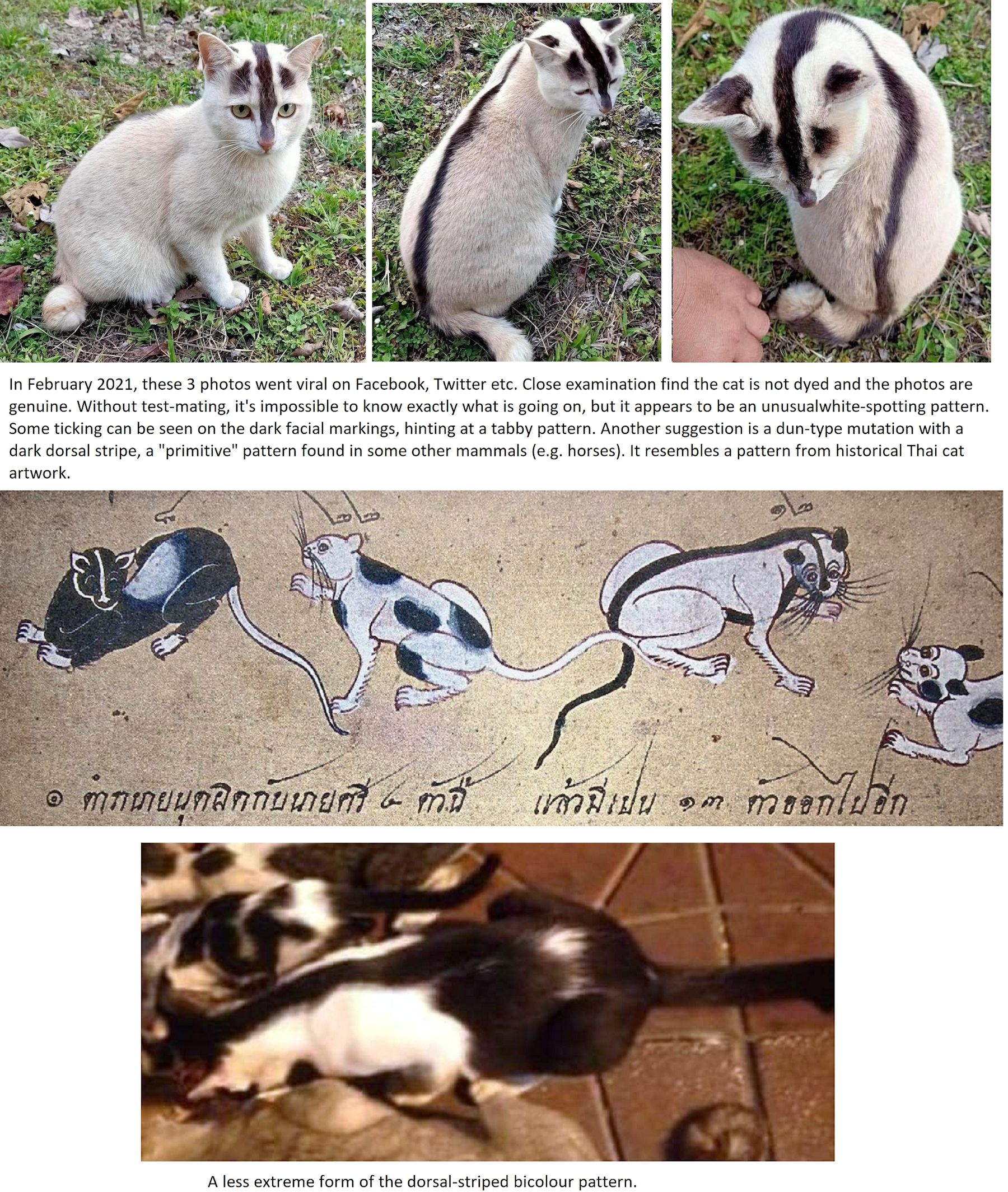
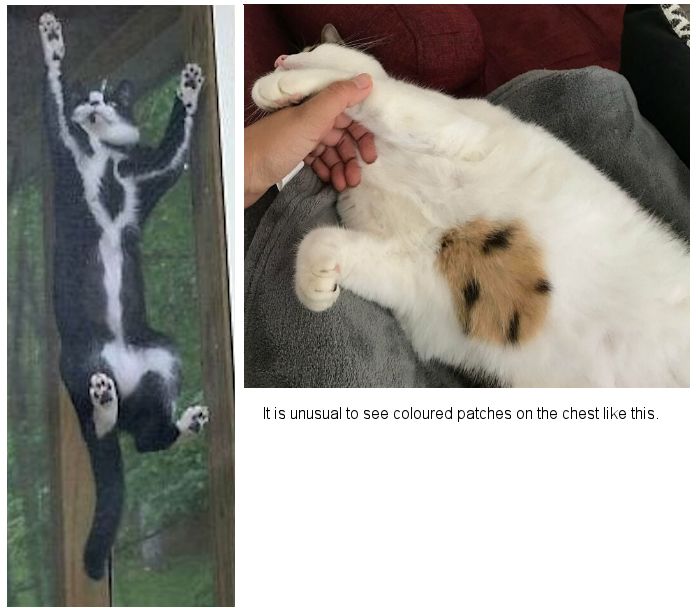
In September 2015, Alaina Hickman, who works with Feline Friendz rescue group in Omaha, NE, sent me some photos of a black kitten, Gogo, that started developing parallel white stripes along her back. The stripes became more pronounced as the kitten gets older. She also found a photo (screen grab shown) of a similar kitten named Jackson. The colour change is similar to the cat depicted in the Thai manuscript, but is most likely to be "fever coat" which can develop in kittens that have been unwell and vanishes at the next moult. Genetically all cats are tabby (a double dose of the non-agouti gene makes the coat solid coloured) and you can see that the white has followed what would have been the dorsal stripe in a tabby cat.
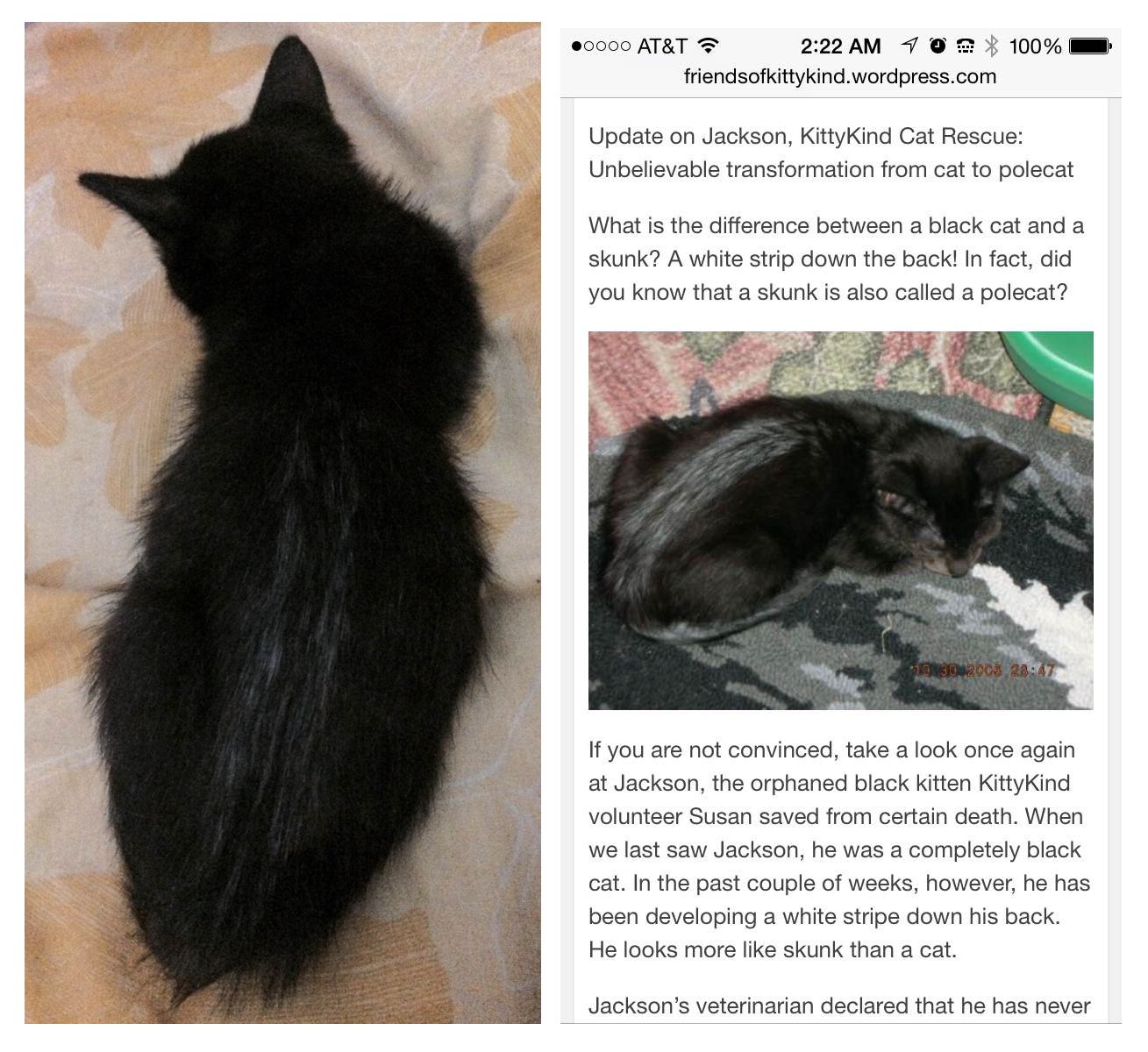
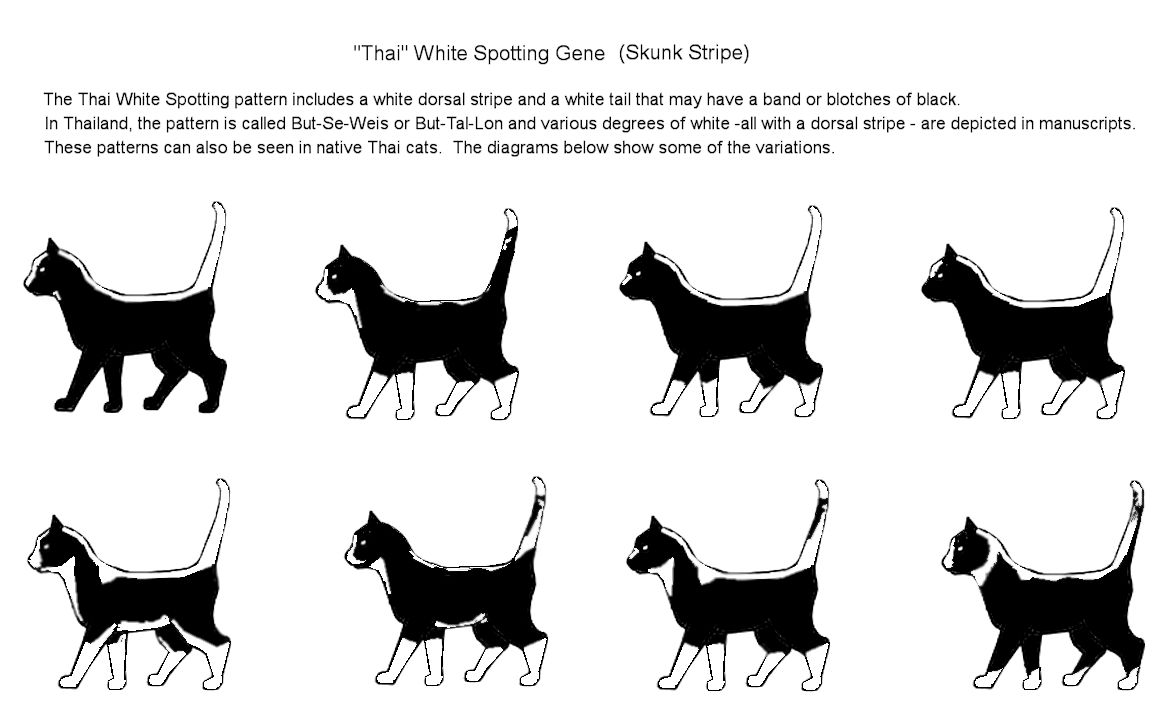
WHITE EAR TUFTS
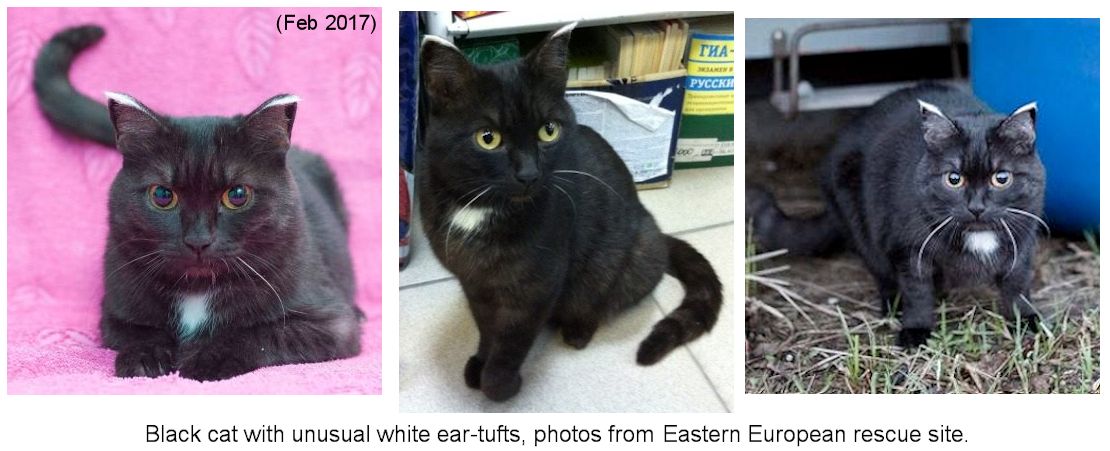
BRINDLED BICOLOURS AND "TWEED" MUTATION
Pandora (owned by Bill B, Granby, MA, USA) is a brindled cat with what appears to be an unusual mutation. She has the brindled pattern normally seen on tortoiseshell cats, but the patches which should be red are white! The brindling and facial pattern is typical of tortoiseshell cats, but it seems that 15 year old Pandora has a mutation that prevents her producing red pigment. An alternative explanation is that Pandora is chimera formed when a black embryo and a white embryo fused in the womb; however chimeras tend to have a patched appearance rather than being thoroughly brindled, this makes chimerism a less likely explanation. A third possibility is that Pandora has additional X chromosomes (XXX or XXXX instead of the normal XX female), however this genetic anomaly is associated with mental retardation and physical anomalies/deformities (this is not Klinefelter syndrome, Klinefelter syndrome is only found in males e.g. XXY or XXXY). These two conditions can be identified using tissue samples, but this isn't recommended in an older cat as it involves sedation or anaesthesia. It seems likely that the gene that should produce red pigment is faulty or that some other gene is masking the red pigment out. Since Pandora was spayed before Bill obtained her, it isn't possible to breed her to see if it can be inherited. I have seen the opposite mutation - where a tortoiseshell cat produced red pigment, but not black, resulting in a red, cream and white brindled cat - but this is the first time I have seen a black-and-white brindle where the red is absent.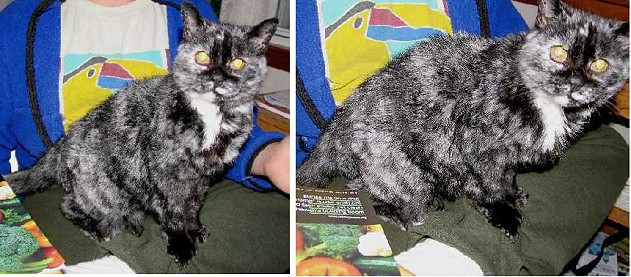
More brindled bicolours are explained in the separate page on Roan, Tweed and "Salt and Pepper" Colours
THE CHINESE HARLEQUIN
During the 1980s, there were attempts to breed shorthaired cats with a black tail, black patches on the head and small black (or other solid colour) patches or spots on the body. Named Chinese Harlequin, it was supposed to resemble cats found in ancient Chinese art. Although still listed by some registries, it appears to now be extinct due to the difficulty of breeding bicolours with consistent spotted markings. A similar "strikingly spotted" cat, the Gao Taem, is seen in ancient Thai art and is described as having, black marked forepaws, black and white ears, black shoulders, two black spots on the back and black shoulders. In total there should be nine horse-like black spots on an all white background. If it existed as a breed, the mutation creating these features has been lost. This appears to be a form of Seychelles (Van) pattern. Some bicolours have black toes or paws and and some breeders have attempted to fix this trait to create a black-footed Van-type bicolour. Also depicted in Thai art (1676) is the Vichiens Mas which is shown as white with dark ears, nose, paws and whiskers. Although depicted as black and white, it seems to be a stylised or idealised depiction of the seal-point Siamese.
GENETICS OF PIEBALD CATSWhen the amount of white is small (under 40%), it is called low-grade spotting and comprises the white belly patch, mitts, locket and blaze. In medium grade spotting, the amount of white varies from 40% to 60% of the coat and is the typical pattern of a show quality bicolour (a mask and mantle effect). When it is extensive (more than 60%), it is called high-grade spotting - the Seychellois or Van pattern.
Piebald spotting is a dominant gene with very variable expression. Low grade spotted cats and some medium grade, spotted cats are heterozygotes i.e. they have only one copy of the white spotting gene. Other medium grade spotted cats and all high grade spotted cats are homozygotes i.e. they have 2 copies of the gene. Where cats are in the medium spotted range it is generally impossible to know whether they are heterozygotes or homozygotes unless they are bred to a cat known to be either homozygous or heterozygous. To further complicate matters for breeders, some apparently non-piebald cats are really piebald cats whose white bits are so minimal they might be no more than a few hairs in the groin or at the tip of the tail!
N = no white genes, DW = Dominant white gene ("solid white"), Ws = White spotting gene
These are the possible genotypes (percentages are averaged over several litters):
N/N genoytpe cats are unlikely to be white (except cats homozygous for recessive albinism gene.) They cannot transmit dominant white or white spotting variant to their offspring.
N/DW genoytpe cats will be white carrying non-white and will transmit the dominant white variant to 50% of their offspring which will, therefore, also be white.
DW/DW genoytpe cats will be white and will transmit dominant white variant to 100%f their offspring, which will, therefore, also be white.
N/Ws genoytpe cats will have white spotting (carrying non-white-spotting) and will transmit white spotting variant to 50% of their offspring, which will, therefore, also be white spotted.
Ws/Ws genoytpe cats will have white spotting and will transmit white spotting variant to 100% of their offspring, which will, therefore, also be white spotted. Ws/Ws cats often have higher degrees of white spotting than N/Ws cats.
DW/Ws genoytpe cats will be white carrying white spotting. They will transmit the dominant white gene to 50% of their offspring and the white spotting gene to 50% of their offspring.
Another cause of white spotting is a somatic mutation i.e. some skin cells have a chance mutation which prevents them from producing pigment. This is not hereditary.
In January 2016, it was announced that piebald patches form when cells fail to develop in the womb. The gene for white spotting affects the embryo cells (melanoblasts) which will become pigment-producing skin cells (melanocytes) which make the pigment for hair. Pigment cells move and multiply as an embryo grows and there aren't enough cells to cover all the skin, so the animal gets a white belly. The findings were published in the journal Nature Communications. The pigment cells 'fail to follow instructions' during early development. They move and multiply randomly as an embryo grows, without complex cell-to-cell communication sending them in one direction as once thought. The University of Edinburgh's Dr Richard Mort said that the cells move and multiply at random which is not what was expected. The University of Bath's Dr Christian Yates said: that piebald patterns could be caused by a faulty version of a gene called kit. What the researchers found was counter-intuitive. Previously it was widely thought that the defective kit gene slowed cells down, but instead they found that it reduced the rate at which the pigment cells multiply. This did not surprise cat fanciers who had noticed that pigmented patches could fit together like a jigsaw and likened the process to plate tectonics where pigmented patches drift across the embryo s skin leaving unpigmented areas inbetween the patches. Researchers at the Universities of Bath and Edinburgh said that in addition to kit, there are many other genes that can create piebald patterns, but their the mathematical model can explain piebald patterns regardless of the genes involved.
This wasn't entirely surprising to many cat fanciers with an interest in genetics or embryology! Independently of scientific researchers, and based on observation, fanciers had some ideas of their own, which have turned out to be close to the mark.
Many cats have patches which look as though they could be fitted together like jigsaw pieces; for example a coloured spot on a leg might correspond to an inlet on a coloured patch on the flank, exactly as though a piece of coloured area has broken off and migrated elsewhere. Spots could end up almost anywhere depending on the timing of cracking, the size of the coloured domains, and the trajectories they take over the embryonic surface as it grows. Terada and Watanabe found it possible to fit all the coloured areas of cat coat together. The seams can then be projected onto the surface of a sphere (the embryo). As the sphere expands, the coloured area cracks apart. Think of a balloon covered in solidified chocolate: the balloon can expand, but the chocolate can't. The cracked solid surfaces then gave patterns just like those found on bicolour cats. The swirled patterns in particular fit this hypothesis.
Part of this theory was that the patterning of black and white was the result of the skin surface "cracking" during early embryo development. The skin of such bicolour cats at an early embryo stage would be basically pigmented, but the dominant WS (white spotting) gene, causes the pigmented surface to crack into domains or islands. These islands drift apart over the embryonic surface as the embryo grows, but the pigment cells don't multiply fast enough to fill the spaces between the island. That leaves white areas in the regions between the islands of pigment. It may help to think of it as similar to the movement of the earth's continents with areas of sea inbetween. It is just as though the white areas were scar tissue produced by the cracking. There are not enough melanocytes available to fill the white areas as their surface expands. This means that the black domains can end up pushed together to form a single tuxedo style black area (albeit there may be some small white markings in this single black area). The white belly area might be a ventral (belly) seam from a ventral crack earlier on - it is suspected that the belly area expands greatly during embryo growth. Megacolon in cats and exposed gut conditions in some rabbits upholds this theory. Black feet could indicate a black domain that has been pushed to the foot extremity by the expansion of the ventral region at the same time that the limbs are being formed.
Where the white spotting occurs over the eyes, it may affect the eye colour. Thus a few bicolour cats have blue eyes. Another interesting effect of white spotting is in tortoiseshell cats. Tortie cats with little or no white tend to have brindled coats with intermingled black and orange hairs. However, the more white there is, the more the black and white will also be separated out into patches instead of being intermingled. This is also explained by the mechanism detailed in the 2016 report findings. The black pigmented cells that have moved across the embryo surface multiply to form black islands (clonal patches), while the red pigmented cells that moved across the surface multiply to form red patches.
OLDER / ALTERNATIVE THEORIES FOR BICOLOUR PATTERNS
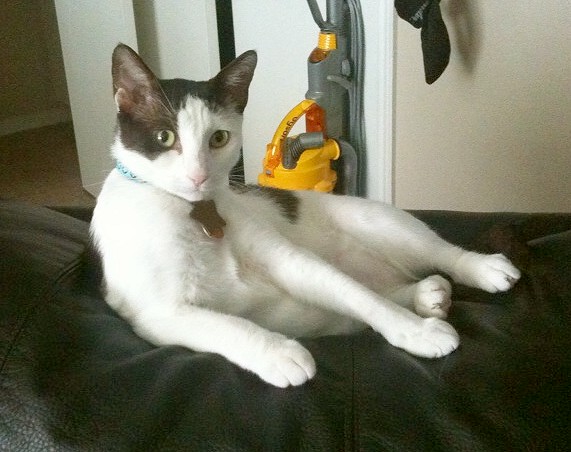
Above: "Olga", an attractive brown bicolour owned by Sarah Richie
It used to be thought that when the melanoblasts arose from the "neural crest" (the area along the back of the embryo) and migrated all over the body as the skni formed. The white areas were areas that the cells didn't reach, which explained why the white is most often found on the paws, belly and chest - those areas are the most remote from the neural crest and take longest to reach. The slower the migration of cells, the less colour there will be. It also explained why the back and the tail may be coloured in an otherwise all white cat - those areas are closest to the neural crest and the pigment cells didn't have to migrate very far.
Another older theory involved either of two cellular mechanisms in white spotting that "turned off" pigment. One mechanism was apoptosis (programmed cell death) reducing the melanoblast (pigment granule) population. In other words, the colour cells migrate over the whole surface of the embryo, but then selectively die out. The other cellular mechanism involved intracellular chemical communication whereby colour cells are biochemically turned off in certain areas. Both of these suggest a chemical gradient so that cells at the extremities tend to be first affected and stop producing colour.
Another hypothesis for the distribution of white was originally presented in papers published by T Terada and T Watanabe in a 1930s Japanese journal. This hypothesis is now being investigated using computer simulation. There are several "unknowns" with the current hypotheses: the relative frequencies of the 10 grades of white spotting given that white spotted cats may be either WSWS or WSws; the relationship, if any, between birth order and patterning; and whether the "swirled" pattern is related to any birth defects or any difficulties during pregnancy. The melanocyte migration hypothesis may not contain the whole story, especially where swirled patterns, black feet on white socks and skunk stripes are concerned.
Some cat breeders believed there were flaws in the conventional melanocyte migration theory. For example a breeder working with American Shorthairs has been crossing Van pattern American Shorthairs to bicolour and spotted Van pattern cats since the mid 1990s. She found that the melanocyte migration theory could not account for some of the spotted patterns these breedings produced. Alternative theories from other white spotting genes and mechanisms in other species (dogs, horse, pigs and goats) also could not account for what was appearing in her cats, particularly with 60%, 70%, 80% and 90% white on a cat. The terminology used differs from the Grades 1 - 9 of the cat fancy; 90% white with a lot of random spots is referred to as Level 15. Selective breeding has isolated most of the white on the cats to a single layer of white. She can now produce solid coloured cats from the mating of two bi-colours/pied/vanish cats. In addition, all of her best breeding cats have black feet. Breeding experiments involved mating a level 15 stud to a solid black, two Level 7 piebalds, and a Level 9 cat. A cat with a large degree of white is most probably homozygous for the white spotting gene and mating it to other white-marked cats which also carry at least one white spotting gene should not, in theory, produce solid-coloured cats. An alternative hypothesis is that the cats have the dominant white gene (the one related to deafness) and that a second gene is causing this to break down so that spotting appears. It is possible to produce coloured cats from mating two all-white cats since each parent needs only one copy of the dominant white gene to make them all white and can carry masked genes for other colours.
